If you’re like 60% of Americans, you probably don’t think you’ve ever eaten a genetically modified (GM) food. Think again. GM foods are everywhere in our food supply. Here’s what they are, and why you should care.
++
“Over salad, they might praise the tomatoes, genetically engineered to stay fresh, firm, and juicy without losing their taste. Or the lettuce, fortified with the genes responsible for broccoli’s rich concentration of nutrients. Or the dressing, made with canola oil that was bioengineered to have the low saturated fat content of olive oil.
For the entrée, the esteemed biologists might relish pork from pigs dosed with a recombinant growth hormone that reduces its fat content by a third. The corn has been engineered to express a toxin that protects it against borers. Even the bread is made with recombinant wheat, a strain enriched with the genes for gluten proteins once found only in premium varieties.
Dessert is not Death by Chocolate but Bananas Immortalité, which delivers a tasty dose of hepatitis B vaccine.”
Excerpt from Science News, by Steve Sternberg
What are genetically modified foods?
When scientists alter the genetic structure of a plant or animal in order to manufacture advantageous traits in the organism, they are engaging in what is called genetic modification (GM).
The resulting product is a genetically modified organism (GMO). GM is a form of food biotechnology.
Basic food biotechnology has been performed for thousands of years. We can look back to 4000 BC when fermentation and malting were mainstays in Mesopotamia. Animal breeders have long selected for particular desirable traits, such as size or temperament.
However, with the advent of genetic technologies, scientists are now snipping genes from microbes, plants, and even animals via restriction enzyme technology and splicing them into the plant genome in order to create new traits like herbicide or insect resistance. Thus, GM is also referred to as recombinant DNA technology (rDNA), transgenic or bioengineering.
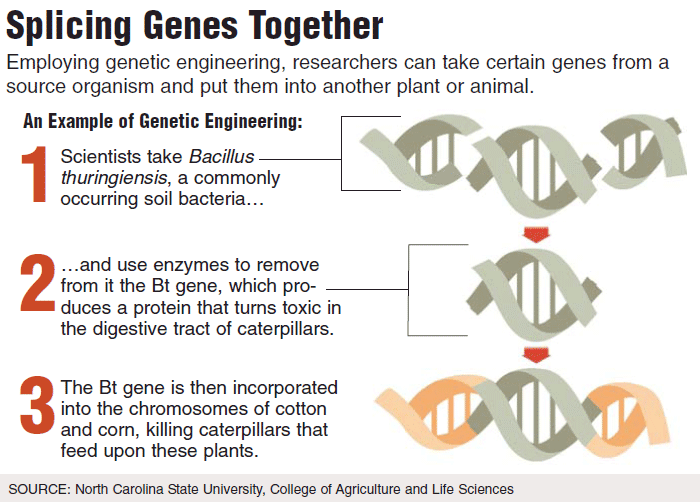
A gene that prevents rotting in beans might be spliced into tomatoes. This produces a tomato that looks and tastes like an unaltered tomato, but is resistant to rotting. Most GM foods are developed to be pest, disease or herbicide resistant.
The Monsanto Corporation accounts for nearly 90% of transgenic traits around the world.
The approved GMs in the U.S. include:
Herbicide resistance
Corn, soy, cotton, canola, rice, alfalfa, beet, flax
Insect resistance
Corn, cotton, potato, tomato
Sterile pollen
Corn, chicory
Virus resistance
Papaya, squash, plum
Delayed ripening
Tomato
Altered oil
Canola, soy
Protein composition
Corn
Reduced nicotine tobacco
Why are genetically modified foods so important?
As the chart below shows, numbers of GM crops are growing around the world.
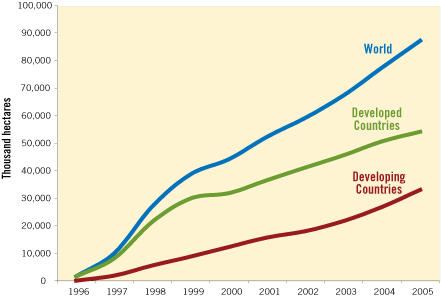
GM foods are developed and marketed because of their perceived advantage over non-GM foods, including:
- Better taste, nutrition and quality
- Increased profit for growers
- Virus and insect resistance
- Herbicide tolerance
- Increased food yield to alleviate world hunger
Those in the opposition feel that GM foods go against Mother Nature. Indeed, the organic food sector prohibits its food to contain more than 5% GM content.
Farmers are worried that GMO will destroy sustainable agriculture and create super-weeds. Biologists are concerned, in particular, about the creation of monocultures— the dominance of a single species. Monocultures can obliterate biodiversity, and are more susceptible to massive crop failures: if a single culture becomes vulnerable to a pest or micro-organism, there are no other varieties to fill in the gaps.
There are also concerns that diverse indigenous species, which are uniquely suited to each microclimate and region, may be lost. For example, it’s estimated that there are 50,000 different types of corn (!) in “genebanks” around the world. There are similarly large numbers of unique potato, rice, and wheat varieties that have evolved within a particular ecosystem, and been carefully cultivated over generations, across the globe.
Those interested in solving world hunger argue that GM foods aren’t an ethical way to address hunger since it works against the values and livelihoods of the people most affected. Moreover, some argue that the current food yield is enough to meet human demands, but due to reliance on animals for food, it isn’t distributed adequately. Data has indicated that GM crop yields aren’t consistently higher than conventional crops and more herbicides must be used.
Various animal studies have identified health risks associated with GM food consumption, including:
- Infertility
- Immune system compromise
- Accelerated aging
- Altered genes associated with cholesterol synthesis, insulin regulation, cell signaling, and protein formation
- Alterations in liver, kidney, spleen and gut function
Additional concerns with GM foods include:
Allergies
Imagine if scientists insert a Brazil nut protein gene into the soy genome to improve the protein content. If someone has a severe allergy to Brazil nuts, what will happen? Some argue that the outcome might be lethal.
Outcrossing
Could genes from GM crops contaminate conventional crops? Some say yes. This may compromise food safety and sustainability.
Recently, farmers in the U.S. launched a class-action suit against Bayer AG after the U.S. Department of Agriculture announced in August 2006 that trace amounts of a Bayer-created, genetically modified rice had been found in commercial long- grain rice in the U.S. Similar cases have occurred in Canada and around the world with crops such as canola and corn.
The development of GM foods
In the beginning of the 1990s, transgenic plants and animals began to appear. In a type of tomato called Flavr Savr, a gene was blocked that accelerates the ripening process. By blocking that gene, the tomato quality could be maintained for a longer period of time. This led to ease of harvesting along with a greater area for distribution.
Genetic modification has also expanded to the animal population. Genetically engineered bovine somatotropin (rBST) has been used to enhance milk production in cows. For more on rBST, see All About Milk.
The increasing popularity of rDNA techniques in the late 1970s prompted Congressial discussions about public safety. In the 1980s, it was decided that “DNA was DNA, no matter what the source.”
In the U.S., four principles were established in 1986:
- Existing laws are sufficient for regulation.
- Regulation applies to the products, not the processes by which they were developed.
- Safety should be assessed on a case-by-case basis.
- Agencies should coordinate their regulatory efforts. This new framework applies to drugs and foods.
This requires collaboration between the United States Department of Agriculture (USDA), the Environmental Protection Agency (EPA), and the Food and Drug Administration (FDA).
Good luck with that. I can’t even get my nephews to pick up their dirty socks.
What you should know about genetically modified foods
As you can see in the image below, a U.S. poll showed that 60% of respondents believed they had never eaten a GM food.
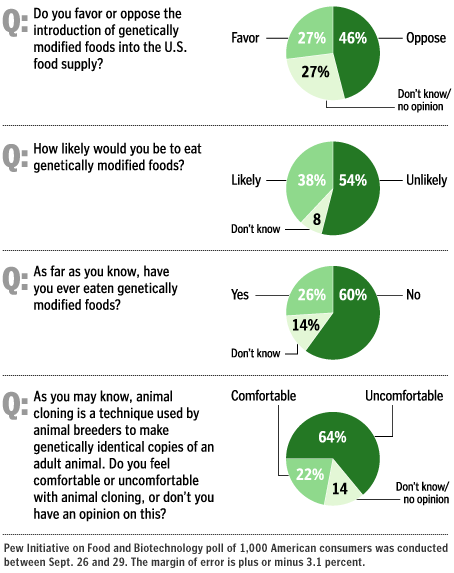
This is unlikely, considering GM foods are estimated to be in nearly 70% of all products found in typical U.S. grocery stores. 80% of all corn and 92% of all soybeans grown in the U.S. are GM. GM beets will comprise over 90% of this year’s U.S. sugar beet harvest.
The idea of using animal genes in plant foods has been considered. In 1991, a company developed a tomato that included a modified gene from a breed of Arctic flounder. This was done to make the tomato more resistant to frost and cold storage. The tomatoes weren’t successful and no one ever consumed a tomato with fish genes. However, this raises concerns with fish allergies and poses an ethical dilemma for those who choose not to consume animals.
A brief history of food biotechnology
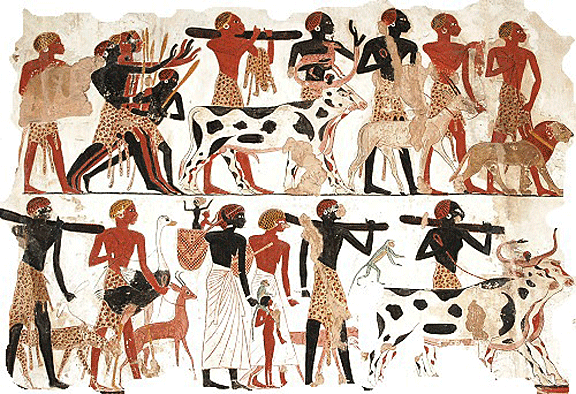
- 4000 BC Classical biotechnology: Dairy farming develops in the Middle East; Egyptians use yeasts to bake leavened bread and to make wine.
- 2000 BC Egyptians, Sumerians and Chinese develop techniques of fermentation, brewing and cheese-making.
- 1500 AD Acidic cooking techniques lead to sauerkraut and yogurt – two examples of using beneficial bacteria to flavor and preserve food. Aztecs make cakes from Spirulina algae.
- 1861 French chemist Louis Pasteur develops pasteurization – preserving food by heating it to destroy harmful microbes.
- 1879 William James Beal develops the first experimental hybrid corn.
- 1910 American biologist Thomas Hunt Morgan discovers that genes are located on chromosomes.
- 1953 James Watson and Francis Crick describe the double helix of DNA
- 1982 First genetically engineered product – human insulin produced by Eli Lilly and Company using E. coli bacteria – is approved for use by diabetics.
- 1986 First release into the environment of a genetically engineered plant (a tobacco).
- 1990 Pfizer Inc., introduces Chymax chymosin, and enzyme used in cheese-making – first product of recombinant DNA technology in the U.S. food supply. The first successful field trial of GM herbicide tolerant cotton is conducted in the USA.
- 1993 After nearly 10 years of scientific review and political controversy, the U.S. Food and Drug Administration (FDA) approves Monstanto Co.’s version of rBGH/rBST to increase milk production.1994 Calgene, Inc., market the FLAVRSAVR tomato – first genetically engineered whole food in the U.S. food supply.
- 1996 Herbicide tolerate GM soy bean available in U.S.
- 2003 Japanese researchers develop a biotech decaffeinated coffee bean.
- 2006 GM rice approved for human consumption in U.S.
- 2007 TheUSDA approved the planting of 11 new pharmaceutical or industrial GM crops.
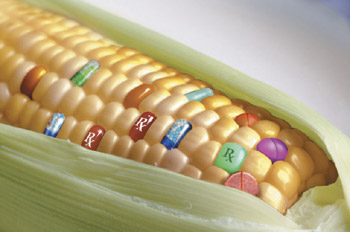
Summary and recommendations
GM is a recent phenomenon with many unanswered questions. Insertion of genes into other genomes may result in unexpected outcomes. Moreover, the long-term effects of GM crops aren’t known and may be serious and irreversible.
If the genesis of GM was truly “public good” rather than corporate profit, sustainable agriculture might be able to draw upon GM technologies as assistance rather than the main feature.
To tell if you are eating a GM food, use the PLU code. (It’s printed on that annoying little sticker that you always have to pick off before you eat fruits and veggies.)
Labels beginning with “9” indicate organic
Labels beginning with “4” or “3” indicate conventional
Labels beginning with “8” indicate GM
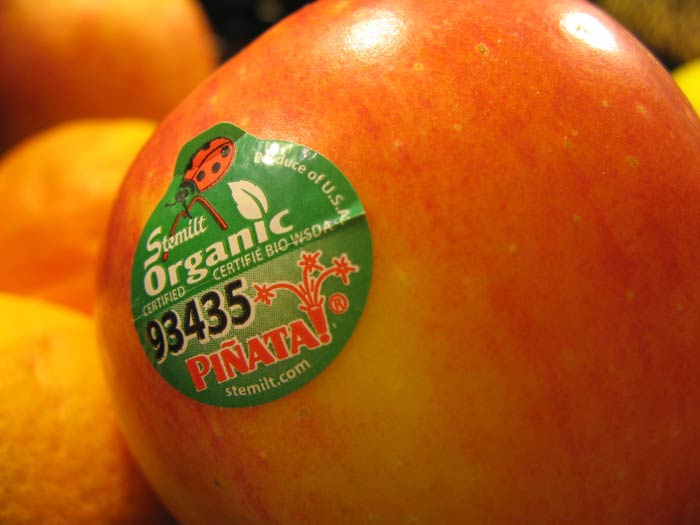
References
Click here to view the information sources referenced in this article.
Eat, move, and live… better.©
The health and fitness world can sometimes be a confusing place. But it doesn’t have to be.
Let us help you make sense of it all with this free special report.
In it you’ll learn the best eating, exercise, and lifestyle strategies — unique and personal — for you.




Share